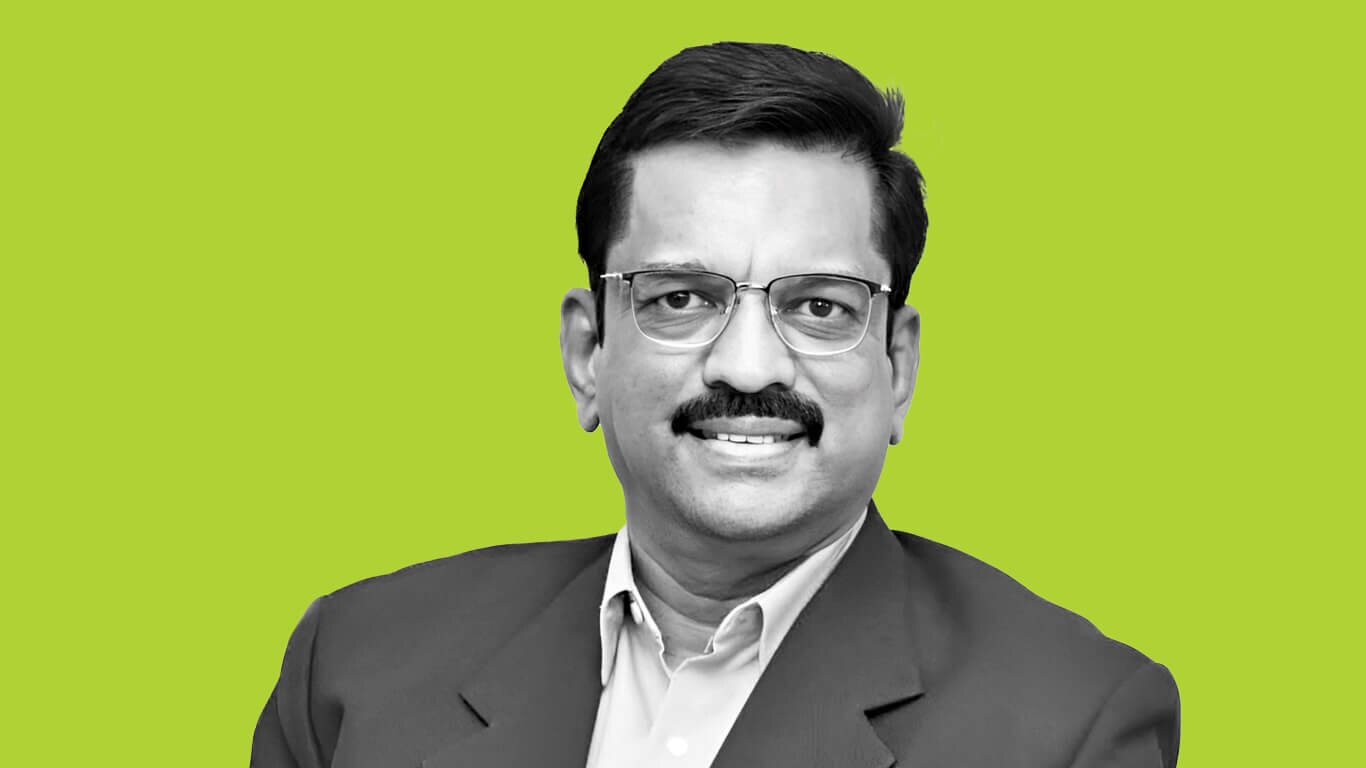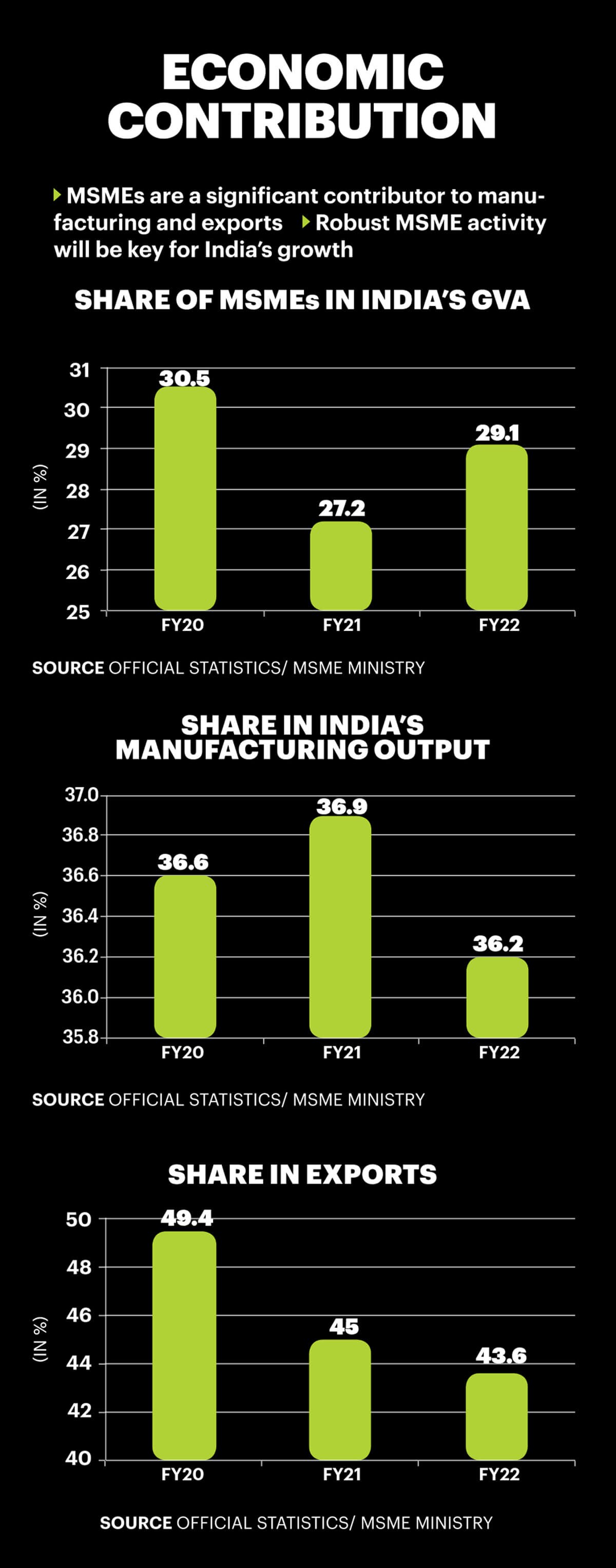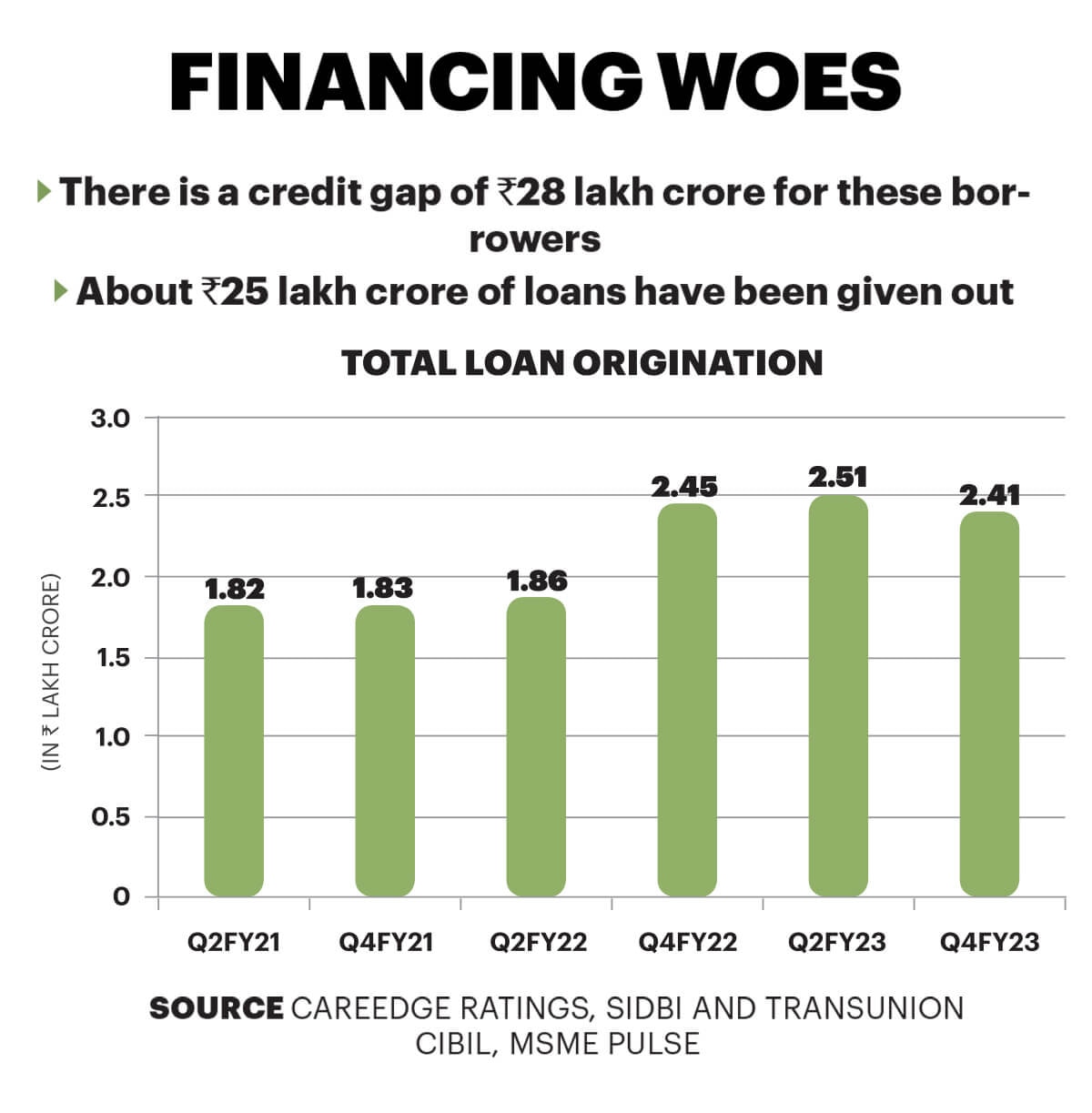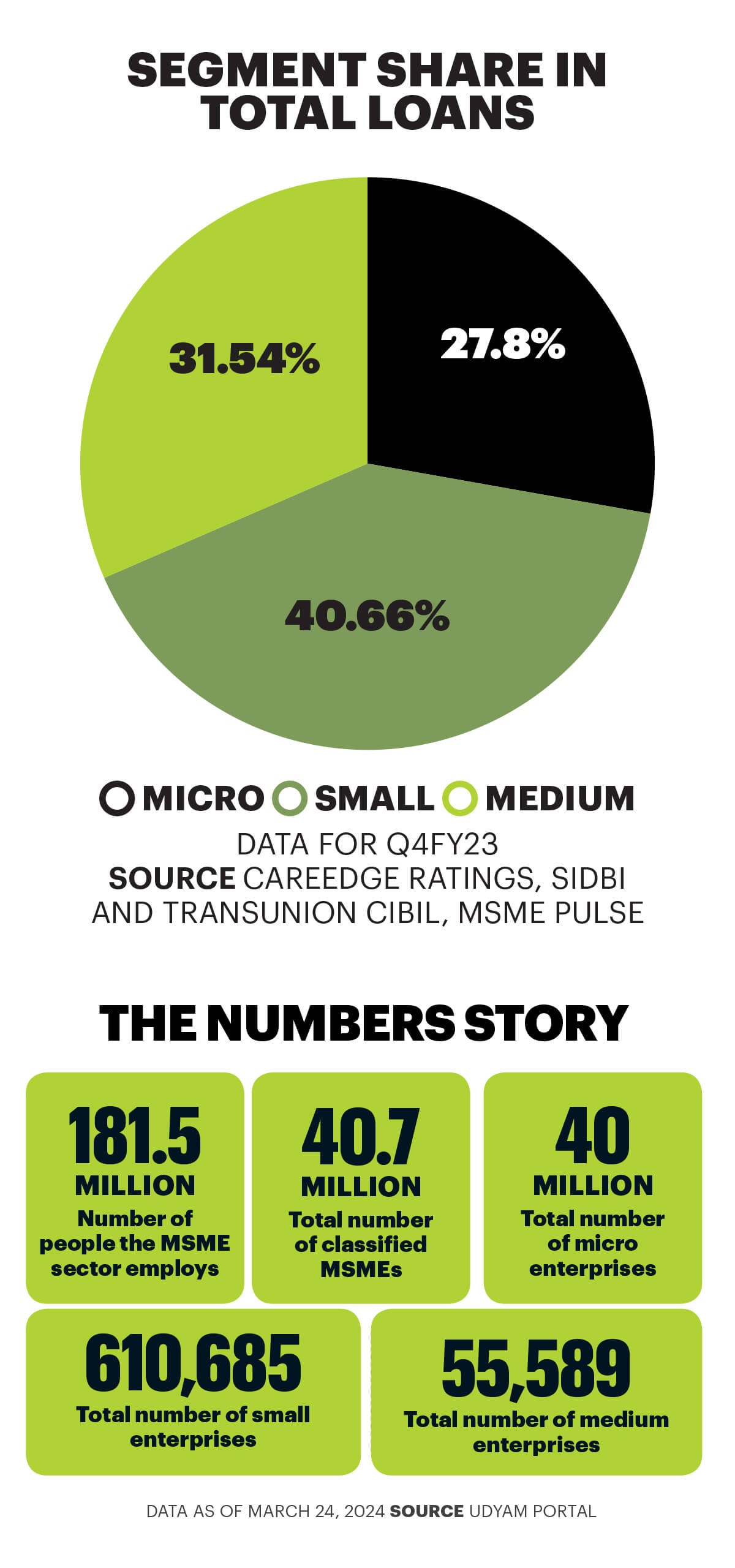
We don't support landscape mode yet. Please go back to portrait mode for the best experience
It’s been a slow and uneven recovery after the pandemic for MSMEs. As they get back to normalcy, several old challenges persist and newer ones are emerging. Addressing them could put India on a much higher growth trajectory
Photos: Hardik Chhabra & Mandar Deodhar

When an MSME goes to a bank for financing, it means that it is a patient and needs to be in the ICU. That is how banks should treat the business. Instead, they ask for several documents and take a long time to lend, if at all,” says Gaurav Kumar Jain, the owner of Meerut-based MSMEs K.R. Industries, K.R. Synthetic and K.R. Rubber, which manufacture a range of rubber, sports goods and fitness equipment.
The district of Meerut in Uttar Pradesh is India’s second-largest producer of sports goods after Jalandhar in Punjab. But problems in sourcing raw material, meeting international quality standards and challenges with ease of doing business are some of the biggest hurdles for MSMEs in the space, says Jain.
His comments are met with laughter by other MSME owners and sectoral experts gathered in his office. Almost all recognise the bitter truth behind his comments even as they grapple with their own challenges. Take Sajid Saifi, President of the Mini Gas and Petromax Spare Manufacturers and Traders Association in Meerut. The mini gas cylinder cluster in Meerut has about 400 units and is looking for a proper space for production. “We want a common facility centre that would help us with adequate space for testing, getting raw materials and production,” says Saifi. But despite its large markets in India and abroad, it has been unable to convince the authorities.

“ The biggest challenges for MSMEs to compete with cheaper imports in India or exports abroad are access to technology and getting timely payments ”
ANIL BHARDWAJ
Secretary General
FISME
Across the city, Ashutosh Agarwal, MD of jewellery firm Bhawani & Bhawani Jewellers, says players in the imitation jewellery space need to invest in technology to become competitive. But formal financing is hard to come by. Jain’s comments also find resonance amongst MSME owners across the country. In Maharashtra’s Kalyan, near Mumbai, chemicals manufacturer Chandan Gupta (name changed on request) is bogged down by the large number of compliance reports that need to be filed every month. “How is a small manufacturer supposed to run his businesses, if he has to meet deadlines to file returns and reports?” he asks. In Ahmedabad, Jaimin Gupta, 29, Founder of men’s apparel maker Barcelona, is worried about the presence of too many central- and state-level policies that could make doing business across states cumbersome. “The current government is big on creating digital infrastructure and it could well look at creating one for MSMEs that helps us meet all state-level compliance requirements,” he says.
In Delhi, J.S. Ahluwalia, MD of freight forwarding and logistics firm Aquatic Freights, says the government doesn’t do enough for MSMEs. “Even during the pandemic, we were left to fend for ourselves… We were lucky. Many businesses couldn’t bear the burden and shut down,” he says.

According to official data, as many as 35,680 MSMEs registered on the government’s Udyam portal have shut since 2019. Experts say the numbers may be higher since many are unregistered. And while the pandemic may be over, millions of MSMEs continue to struggle with several old challenges even as newer ones are emerging.
While a full recovery remains elusive, experts say that easing ground-level issues and simpler compliances could improve MSMEs’ productivity, giving a boost to job creation and economic growth. Despite the modest nature of their operations, MSMEs are a force to contend with in the Indian economy. These firms—that can range from a single-person unit to medium-sized companies that employ dozens of workers—are the country’s second-largest job creator after agriculture, contribute a third of the GDP, and 45% of national exports. It is estimated that there are more than 66 million MSMEs in India, with a little over 40 million being registered with the government, as of March 15, 2024.
Anil Bhardwaj, Secretary General of the Federation of Indian Micro and Small & Medium Enterprises (FISME), says MSMEs have seen a K-shaped recovery since Covid-19. Many in contact-intensive sectors such as tourism, travel and hotels have shut shop; those that survived are on the mend. Those in food processing, pharma, auto and engineering were not impacted and continue to do well. “Problems continue for sectors such as garments and textiles, leather and gems and jewellery, and capital goods that are exposed to the global markets... Many of these markets are now entering into recession and these companies are the worst hit,” says Bhardwaj.
While government spending on infrastructure and housing, and the resurgence in domestic demand have given a boost to these sectors, there continues to be pain points. “The biggest challenges for MSMEs to compete with cheaper imports in India or exports abroad are access to better technology and getting timely payments,” says Bhardwaj.
K.E. Raghunathan, National Chairman of Chennai-based Association of Indian Entrepreneurs (AIE), distils MSMEs’ problems down to 5Ms: money, marketing, materials, manpower, and modernisation. “These vital needs of MSMEs have been poorly addressed by policymakers… For any policy intervention, there is a need for data but… the Ministry of MSME is yet to collect data on all existing MSMEs,” he says.
Labour economist Santosh Mehrotra, a retired JNU professor, agrees. “There is not any updated data on MSMEs for comprehensive policy action. The NSSO conducted the Unincorporated Non-Agricultural Enterprises sample survey in a five-year interval and the last report is available for 2015-16,” he notes.
Nirav Shah, Founder of Zyapaar, a networking platform for MSMEs, says the three key challenges are credit access, technology and digital adoption, and market access. “Because of these challenges, there is a huge gap between what the MSMEs are doing and what they can do.”

“ Money, marketing, materials, manpower, and modernisation—these vital needs of MSMEs have been poorly addressed by policymakers ”
K.E. RAGHUNATHAN
National Chairman
AIE
The biggest challenge for MSMEs is getting timely payments. According to some estimates, as much as Rs 10.7 lakh crore of dues for small businesses are stuck. Ahluwalia of Aquatic Freights says it took one and a half years to get a payment from a central government ministry for an overseas consignment, and another six months to get paid by a large private infrastructure company. “The MSME Samadhaan portal made us run back and forth between Delhi and Mumbai and eventually did not yield any result,” says Ahluwalia when asked about recourse to arbitration. The Samadhaan portal was set up in 2017 to monitor delayed payments and ensure they are paid in a time-bound manner.
There are other policy measures. Under the MSME Development Act, 2006, if payment is not made within 45 days of receiving the goods or service from the supplier, the buyer must pay compound interest with monthly rests (where interest is calculated based on the outstanding balance) to the supplier on the amount at thrice the notified bank rate. But such measures have seen mixed results. While MSME facilitation centres in each state can settle such disputes, industry players say that cases can drag on for months. Even after the award of the payment, the buyer may default on it or appeal against it. The MSME ministry is looking at amendments to the Act to ensure the award of dues is implemented.
In 2014, the Trade Receivables Discounting System (TReDs) was launched as an electronic platform to facilitate financing and discounting of receivables from MSMEs and help them receive funds against approved invoices within 48 hours. While invoice processing on TReDs is understood to have hit about Rs 11,000 crore per month, AIE’s Raghunathan says many state governments have not yet accepted it, and many corporates don’t care about it.
The proposed implementation of a new income tax provision from April 2024 has thrown MSMEs into a tizzy. The Finance Act 2023 inserted a new clause (h) in section 43B of the Income Tax Act under which, if a company fails to pay an MSME within 45 days, the dues would be added to the buyer’s profit and taxed.
While the aim is to promote timely payments to small businesses, MSMEs are worried that this could impact their relations with clients. Some have even given up their MSME registration to ensure clients continue to do business with them. Industry bodies have sent representations to the finance ministry to either extend the period to 90 days or defer its implementation. Praveen Khandelwal, Secretary General of the Confederation of All India Traders (CAIT), says the entire supply chain needs to be brought into it. “Otherwise, it can lead to a huge income tax liability for companies.” CAIT has called for the implementation to be deferred to April 1, 2025.

The perennial challenge for MSMEs remains the funding gap. Getting financing from formal lending channels such as banks and NBFCs at the right time and right rate is crucial, but for most it involves a series of meetings and providing adequate collateral. The credit gap in the sector was pegged at Rs 20-25 lakh crore by a report of the Expert Committee on MSMEs headed by former Sebi Chairman U.K. Sinha in 2019. This is seen to be higher now. According to estimates, less than 40% of MSMEs avail credit from formal financial systems. “The credit gap for MSMEs is about Rs 28 lakh crore at present but this will increase further as the informal sector enterprises transition into the formal sector,” says Sanjay Agarwal, Senior Director at CareEdge Ratings.
To some extent, the government’s measures have helped bridge this gap. Bank lending to MSMEs is currently at Rs 22 lakh crore while NBFCs have lent Rs 3 lakh crore. These include bringing MSMEs into priority sector lending (PSL) and the Rs 5 lakh crore Emergency Credit Line Guarantee Scheme (ECLGS) to support businesses. As of March 31, 2023, guarantees amounting to Rs 3.61 lakh crore had been issued under ECLGS, benefitting 11.9 million borrowers.
MSME ministry officials also point to additional capital infusion of Rs 9,000 crore into the Credit Guarantee Fund Trust for Micro and Small Enterprises to enable additional credit of Rs 2 lakh crore with a reduced cost of credit. The government has also established the Credit Guarantee Scheme for Startups, under which loans to 106 start-ups amounting to Rs 265 crore have been guaranteed. Other measures include the Startup India Seed Fund Scheme and Startup India Fund of Funds for Startups. Bharadwaj of FISME suggests that the government can consider floating a large dedicated commercial bank. “A commercial bank for MSMEs with a branch in every district could help MSMEs in a big way,” he says.

At a recent webinar, CareEdge Ratings summed up the major stumbling blocks for MSMEs in accessing formal credit: requirement for collateral, lack of credit history and financial record, the seasonal nature of business of MSMEs, and the lack of awareness and financial literacy. CareEdge’s Agarwal notes that gross NPAs for MSMEs is at an all-time low. “As more data becomes available on MSME borrowers, the comfort of lenders will increase… Due to repayment data available with credit bureaus, MSME borrowers are also becoming more careful in making timely payments,” he says. The quality of banks’ MSME portfolio has shown improvement with gross NPAs declining to 4.7% in September 2023 from 7.7% a year earlier. Shachindra Nath, Founder and MD of U GRO Capital, an MSME lending-focussed fintech, adds that as formalisation of the sector continues and companies have more data and the ability to collate it, credit to the sector will increase. “The next 10 years could be the golden age of MSMEs and with the right credit financing, they could contribute as much as 40% to the GDP.”
The government is trying to nudge unregistered MSMEs into the formal sector so that they can avail the benefits of various schemes and access to bank credit. But the transition has not been easy. Demonetisation and the GST roll-out were seen as major stumbling blocks and then the pandemic happened. Many also prefer to stay off the books as it allows them to operate without regulatory scrutiny.
“The formalisation gap remains high, and we are focussing on getting more registrations on the portal to help percolate the benefits of schemes to MSMEs,” says a senior official from the MSME ministry. “The biggest issues are the formalisation gap, credit gap and the need for handholding for technological support. We believe these are opportunities,” says the official, who declined to be identified. Government data shows that more and more MSMEs are moving towards registering on the portal, which assigns them a permanent identity number. This enables them to avail facilities such as PSL, collateral-free loans, subsidy for patent registration and lower electricity charges.

A total of 40.7 million businesses are registered on the Udyam and Udyam Assist Platform (that registers informal micro enterprises) and they cumulatively employ more than 181.5 million people, as of March 24, 2024. In July 2021, retail and wholesale traders were also allowed to register on the portal, but only for PSL. Experts say that given the diverse entities that form the sector, there is a need for more clarity on what constitutes an MSME. This would also help in better percolation of policies to the grassroots.
The composite criteria to qualify as an MSME is linked to investment in plant and machinery and annual turnover. Micro units can have investment in plant and machinery of not more than Rs 1 crore and annual turnover of not more than Rs 5 crore; small enterprises (Rs 10 crore; up to Rs 50 crore); and medium businesses (Rs 50 crore; up to Rs 250 crore). But MSMEs can range from one running a boutique from home to a company that manufactures electrical transformers. Rajendra Agrawal, Lok Sabha MP from Meerut and Convenor of a forum of MPs across party lines called Friends of MSMEs, says it is necessary to classify MSMEs “not only capital-wise but also industry wise”. Khandelwal says wholesale and retail traders would like to be included in the overall definition for more benefits.
Given the complex and diverse nature of many of these problems, finding solutions may take time. But a common thread running through all these businesses is that of optimism, grit, and the belief that they can grow and do well with the right kind of support. If they manage to make their way out of this labyrinth of problems, these businesses could very well be the building blocks on which India can become an economic superpower.
(With inputs from Ashish Rukhaiyar)
UI Developer: Pankaj Negi
Creative Producer: Raj Verma
Videos: Mohsin Shaikh
Photos: Hardik Chhabra & Mandar Deodhar